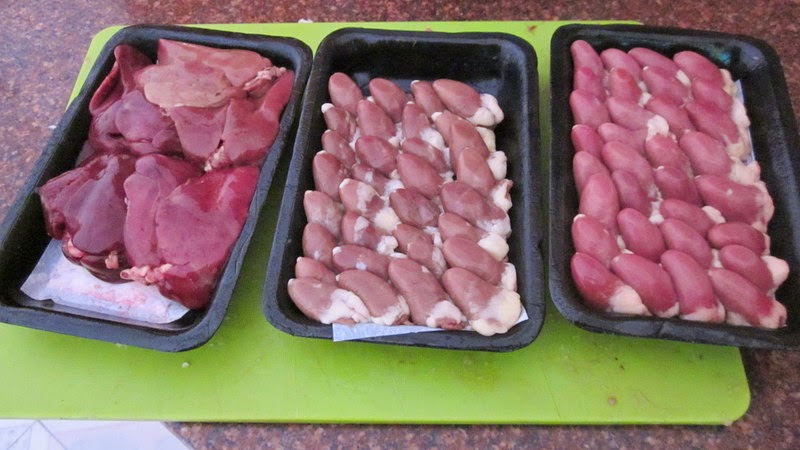I ring up my tuktuk driver and ask him to take me to Lucky Supermarket, which still has the best prices I've found on the chicken parts. Yes, the Cambodians pay much less at the wet markets, but as a white foreigner, I've still not managed to negotiate prices lower than Lucky's. My biggest gripe with the supermarket is that everything comes on those damned polystyrene trays, so every batch of BARF means five of those trays go into the waste stream.
When I get home, I start by laying out the non-meat ingredients:
 |
| Egg yolks, vitamins E and B-complex, fish oil capsules, and virgin coconut oil, made locally by Coco Khmer |
Considering that I'm a vegetarian myself, I'm a bit alarmed by how much I relish using my meat cleaver. WHACK! Off come the wings and legs. Then I slice the meat off the body and cut it into chunks. This gives the cats something to tear and gnaw at, which is excellent exercise for their jaws and teeth. The rest of the bird goes into the meat grinder, bones and all.
It's a toss up which delights me more: my heavy Thai meat cleaver, or my ruthless Russian grinder. It gobbles up drumsticks and backbones with aplomb.
If I ever do this on a larger scale, I think I'll probably need to invest in an electric grinder, but this one gives at least my right arm a good workout, and there's no part of it that's likely to fail or break.
 |
| 200g of chicken livers; 400g of chicken hearts |
Then I mix it all together -- the non-meat ingredients, the chunked and ground chicken and the ground organs.
 |
| Et voila! BARF. |
Each batch will fill five ice cube trays. Once frozen, I empty the trays, putting the BARFcubes into zip-lock freezer bags.
 |
| Yes, these are ice cube trays that I use only for cat food. I don't relish the thought of BARF-infused gin. |
 |
| nom nom nom ... |
So, here are the economics of this little exercise:
One batch of BARF will feed my two cats for 14 days.
The rough cost per batch is $16.
Time, including prep-work and clean-up: about two hours.
My current freezer, however, can only hold two batches of BARF. If I am going to do this on a commercial scale, even small-scale, I have to invest in a chest freezer -- an expensive item, both to buy and to run in a country with very high electric tariffs. The question, of course, is how large the potential market for this luxury cat food might be. Maybe I should make up some brochures and put them at the Agrovet Clinic, just to explain what the raw food is about, why it's so great, and contact details to obtain a sample. The vets had told me they would promote my BARF, so I guess the next step is to see how many cat people will actually pay for something that is colossally superior to Friskies... but 4-5 times the price. As for me, I'm thrilled! My home-made raw food is about 1/3 the price of the high-end commercially canned foods and 1/4 the price of the freeze-dried raw.



As a fellow vegetarian, I can't imagine having your level of dedication and commitment to keeping your furbutts healthy and happy. I love my babies but I will stick to buying commercial food from the vet, the best that I can afford, because I am not sure I can get used to the sight, smell and texture of dead animal bodies.
ReplyDeleteWow you've been really productive eh! I like the cost break down! The Freezer is a pain.. I pray your business Booms and you can invest in one soon! How about making it 2 days pre-order in advance so that gives you time to roll the orders?
ReplyDeleteAn excellent idea! The two day pre-order would be a perfect way to gauge the market. Thank you, my dear! :-)
Delete